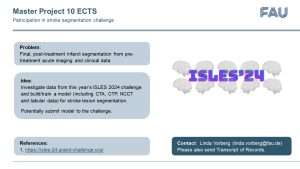Index
Time Series Calving Front Snakes
Artifacts Simulation in CT Images
Introduction:
Computed Tomography (CT) is a powerful imaging modality, but its images often suffer from artifacts that can obscure crucial diagnostic information. Physics-informed artifact simulation offers a promising solution by realistically modeling artifact generation based on underlying physical principles. This approach enables improved artifact understanding, provides realistic training data for machine learning algorithms, and allows for robust evaluation of artifact correction techniques.
This project will focus on exploring state-of-the-art techniques for simulating various types of CT artifacts and investigating their impact on image quality. We will assess the potential of utilizing these simulations to develop advanced artifact reduction methodologies. By further researching this cutting-edge field, we hope to contribute to the continuous improvement of the accuracy and reliability of CT imaging.
Requirements:
- Completion of Deep Learning is mandatory.
- Proficiency in PyTorch is essential.
- Strong analytical and problem-solving skills.
Prospective candidates are warmly invited to send their CV and transcript to yipeng.sun@fau.de.
Evaluation of Reference-Free Registration Methods for Dynamic Vascular Roadmaps
Evaluation of the novel class of promptable image segmentation foundation models for radiotherapy tumor autosegmentation
Enhancing Inference Efficiency of Deep Learning Models for Camera-Based Road Segmentation
ISLES Challenge 2024: Infarct segmentation from CT images

Final, post-treatment infarct segmentation from pre-treatment acute imaging (CT) and clinical data.
Idea: Investigate data from this year’s ISLES 2024 challenge and build + train a model for stroke lesion segmentation. Potentially submit the model to the challenge.
Reference: https://isles-24.grand-challenge.org/
Defect Detection Probability as a Metric for CT Image Quality Assessment
This project focuses on using defect detection probability within CT (Computed Tomography) images as a metric for assessing image quality. Key steps include:
- Establishing a data preparation pipeline to insert defects into CT volumes sourced from CAD files.
- Simulating CT scans to replicate imaging processes.
- Developing a defect detection neural network to analyze CT images and determine the probability of defect presence.
- Utilizing the defect detection probability as a quantitative metric for evaluating the quality of CT images, with potential integration of trajectory optimization techniques.
Automated ONNX2TikZ: Generating LaTeX-TikZ Diagrams of Neural Networks
This project aims to automate the conversion of ONNX models into TikZ code, facilitating the creation of visually appealing diagrams in LaTeX documents. Leveraging Python for ONNX parsing and manipulation, alongside LaTeX and TikZ for rendering, this tool streamlines the process of visualizing neural network architectures for academic papers, presentations, and educational materials
Review of Zero-shot, Few-shot classification, detection and segmentation methods in Medical Imaging
Review of Zero-shot, Few shot classification, detection and segmentation methods in medical imaging.
Evaluation of MedKLIP for Zero-shot and Fine-tuned classification of CXRs
Zero-shot scores on NIH and RSNA Pneumonia datasets. Analysis of attention maps and point score on VinDR-CXR dataset. Analysis of performance improvement from zero-shot to fine-tuned classification performance for various findings.